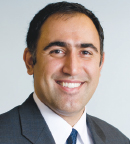In June 2016, the European Hematology Association Congress convened in Copenhagen, Denmark. The educational and scientific program highlighted state-of-the-art clinical practice and the latest findings in hematology research. The ASCO Post brings its readers brief summaries of some of the important studies presented at this meeting, focusing on multiple myeloma, different types of leukemia, and non-Hodgkin lymphoma.
Positive Results Continue for Daratumumab

This combination [lenalidomide/dexamethasone] with daratumumab potentially represents a new standard of care for myeloma patients after one or more previous treatments.— Meletios A. Dimopoulos, MD
Tweet this quote
When combined with lenalidomide (Revlimid)/dexamethasone in the phase III POLLUX trial, the monoclonal antibody daratumumab (Darzalex) significantly reduced the risk of disease progression or death in patients with relapsed or refractory multiple myeloma.1 The triplet produced the highest response rates ever seen in this patient population, according to Meletios A. Dimopoulos, MD, of the National and Kapodistrian University of Athens.
“The combination induces deep and durable responses and improves in a very dramatic way patients’ progression-free survival,” he reported at the Presidential Symposium of the 2016 European Hematology Association Congress. “This combination with daratumumab potentially represents a new standard of care for myeloma patients after one or more previous treatments.”
The POLLUX study was conducted in 569 patients who had received at least 1 previous line of therapy. Patients were randomized to receive lenalidomide at 25 mg plus dexamethasone at 40 mg alone or lenalidomide/dexamethasone plus daratumumab at 16 mg/kg once a week for 8 weeks, once every 2 weeks for 16 weeks, and then once every 4 weeks until disease progression.
At a median follow-up of 13.5 months, daratumumab reduced the risk for disease progression or death by 63% (P < .0001), which was similar to the 61% reduction in the risk for disease progression or death (P < .0001) seen with daratumumab plus bortezomib (Velcade)/dexamethasone in a similar patient population in the phase III CASTOR study, reported during the Plenary Session of the 2016 ASCO Annual Meeting.2
The daratumumab regimen also significantly improved progression-free survival, the median for which was not reached in that arm, compared with 18.4 months in the control arm (P < .0001). Overall response rates were 93% vs 76%, respectively (P < .0001), and the rates of deep responses were significantly improved as well. “It is particularly important that not only 93% of patients achieved at least a partial response, but as many as 43% of patients achieved a complete response,” Dr. Dimopoulos revealed.
Several adverse events were increased in the daratumumab arm. Grade 3 or 4 treatment-emergent adverse events included neutropenia (52% vs 37%), thrombocytopenia (13% vs 14%), and anemia (12% vs 20%). Infusion-related reactions occurred in 48% of patients, but most were grades 1 or 2 and confined to the first infusion.
Novel Antibody-Drug Conjugate in AML
In previously untreated older patients with acute myeloid leukemia (AML), the CD33-directed antibody-drug conjugate vadastuximab talirine (SGN-CD33A) plus a hypomethylating agent resulted in a number of deep, long-lasting remissions, a phase I study found.3

Vadastuximab talirine and [hypomethylating agents] provide a favorable balance of safety, tolerability, and activity among older patients with AML.— Amir T. Fathi, MD
Tweet this quote
The objective response rate was 76% to the upfront combination of vadastuximab talirine and a hypomethylating agent. Seventy-one percent of the patients achieved a remission, with 41% achieving a complete remission and an additional 30% of patients experiencing a complete remission with incomplete platelet or neutrophil recovery. No dose-limiting toxicities were observed, according to Amir T. Fathi, MD, of Massachusetts General Hospital and Harvard Medical School in Boston.
“This high of a remission rate in this traditionally high-risk and difficult-to-treat population is very compelling,” Dr. Fathi commented. “Response rates were higher and were achieved more quickly than would be expected from historical data with [hypomethylating agent therapy] alone. Vadastuximab talirine combined with [hypomethylating agents] provide a favorable balance of safety, tolerability, and activity among older patients with AML.”
The study enrolled 53 patients with CD33-positive AML; more than one-third had adverse cytogenetic risk factors, with remaining patients harboring intermediate-risk cytogenetics. Patients were treated with vadastuximab talirine at 10 µg/kg every 4 weeks along with azacitidine or decitabine at their standard doses. Responders could continue on vadastuximab talirine until disease progression. After a median of 18.9 weeks, 36% of the patients remained on treatment.
In those achieving a complete remission, 42% also became negative for minimal residual disease, as measured by multiparameter flow cytometry, and one-third of patients achieving complete remission with incomplete platelet or neutrophil recovery also achieved a minimal residual disease–negative state. The highest risk patients responded as well as lower-risk patients, with 83% of patients with adverse-risk cytogenetics and 73% of patients with antecedent myelodysplasia achieving a complete remission or with incomplete platelet or neutrophil recovery.
“The high response rate seen with the combination across these risk groups was quite compelling,” Dr. Fathi commented. Overall survival data are maturing, but in the first 25 patients, it was nearly 13 months. Median relapse-free survival was 7.7 months.
The most frequently observed treatment-related adverse events, across all grades, were fatigue (57%), thrombocytopenia (53%), nausea (49%), febrile neutropenia (45%), constipation (42%), and anemia (42%). There were few off-target nonhematologic side effects.
A placebo-controlled, randomized phase III trial, the CASCADE trial, will evaluate the combination of vadastuximab talirine with a hypomethylating agent vs a hypomethylating agent alone in older, newly diagnosed patients.
Blinatumomab Doubles Survival in ALL vs Chemotherapy

The drug [blinatumomab] showed an almost twofold increase in overall survival compared with standard of care.— Max S. Topp, MD
Tweet this quote
Blinatumomab (Blincyto), the first drug in the new class of bispecific T-cell engager (BiTE) antibodies, significantly improved overall survival, as a single agent, over chemotherapy in adult patients with relapsed/refractory acute lymphoblastic leukemia (ALL).4 “The drug showed an almost twofold increase in overall survival compared with standard of care,” said Max S. Topp, MD, of the University Hospital of Wörzburg, Germany, who presented results from the phase III TOWER trial.
In the prespecified intent-to-treat analysis, the primary endpoint of median overall survival was 7.7 months in the blinatumomab group compared with 4.0 months in the chemotherapy arm—a 29% reduction in risk (P = .011). Blinatumomab is the first immunotherapy to demonstrate an overall survival benefit compared with chemotherapy in relapsed/refractory ALL, according to Dr. Topp.
TOWER enrolled 405 patients with relapsed or recurrent ALL. Patients were randomly assigned to receive blinatumomab (n = 271) or one of four standard chemotherapy regimens according to physician’s choice (n = 134). Patients achieving remission after two induction cycles could continue on the drug until relapse.
Secondary endpoints were also improved with blinatumomab, which produced higher response rates and more complete remissions (39% vs 19%; P < .001). Rates of complete remission with partial or incomplete hematologic recovery were also higher with blinatumomab (46% vs 28%, P = .001), he reported.
Adverse events, including neurologic events (which have been a concern with this drug), were comparable for patients receiving blinatumomab and for those receiving chemotherapy. Neutropenia was less common in the blinatumomab arm (38% vs 58%), as were infections (34% vs 52%).
Dr. Topp commented on the lack of neurotoxicity in this study. “Previous studies have shown much higher rates of neurologic events with blinatumomab, but the rate was decreased to only 9% in this study, which is nearly the same as the standard of care,” he explained. “We believe that is due to better management strategies.”
Since blinatumomab is a form of immunotherapy, cytokine-release syndrome is also a risk. This side effects was reported in 5% of blinatumomab patients and none of the control group.
Refinement of CAR T Cells in Lymphoma

Stephanie L. Goff, MD
A new strategy for treating advanced lymphoma with anti-CD19 chimeric antigen receptor (CAR) T cells—pretreating with low-dose chemotherapy—produced impressive, durable responses with potentially less toxicity, in a study reported by Stephanie L. Goff, MD, a surgical oncologist with the Surgery Branch of the National Cancer Institute, Bethesda, Maryland.5 “Anti-CD19 CAR T cells preceded by low-dose chemotherapy have significant activity against advanced lymphoma,” Dr. Goff said.
Despite lower doses of a conditioning regimen, however, a number of patients still experienced neurotoxicity. “In contrast to most reported anti-CD19 CAR trials in leukemia, the most troublesome side effects in our lymphoma patients have been neurologic,” she indicated. Effects include confusion, dysphasia, encephalopathy, and gait disturbances.
CAR T cells have shown strong activity against B-cell malignancies. Dr. Goff’s team has reported good results with CAR T cells in patients with relapsed or refractory B-cell malignancies who received a high-dose chemotherapy–conditioning regimen, which can enhance the activity of the transferred T cells. Their concern was that the high-dose chemotherapy—especially the high levels of the alkylating agent cyclophosphamide—might have masked the effect of the CAR T cells.
To determine whether an easier-to-give, lower dose of chemotherapy might be just as effective and less toxic, they evaluated this approach in 22 patients with lymphoma: 19 had diffuse large B-cell lymphoma, 2 had follicular lymphoma, and 1 had mantle cell lymphoma.
All patients received a low-dose chemotherapy regimen. All were treated with cyclophosphamide for 3 days, 18 of them with 300 mg/m2 daily and 4 with 500 mg/m2. They also received fludarabine at 30 mg/m2 on the same schedule as the cyclophosphamide and were infused with a single dose of CAR T cells 2 days after chemotherapy was completed.
The overall response rate for the 22 patients was 73%, with 12 patients (55%) achieving a complete response and 4 (18%) having a partial response. Of the 19 patients with diffuse large B-cell lymphoma, 68% responded, including complete response in 9 patients (47%) and partial response in 4 patients (21%). None of the patients with complete responses has yet relapsed, Dr. Goff reported.
Several changes were observed in serum protein levels, as a result of the low-dose conditioning regimen. The median peak blood CAR-positive cell concentration achieved with this regimen was 47/μL (range, 4–1,217/μL). High peak levels of the CAR T cells were significantly associated with remission (P = .026), but they were also associated with neurologic toxicity (P = .003), which occurred at grade 3 or 4 levels in 12 of the 22 patients (55%). Analysis of a 41-protein biomarker panel revealed that patients with neurotoxicities had higher peak levels of interleukin 10 (IL-10), granzyme B, and IL-15. These high-grade side effects completely resolved, she reported.
Remissions in CML Even After Tyrosine Kinase Inhibitors Are Stopped

Johan Richter, MD
Patients with chronic myeloid leukemia (CML) being sustained on tyrosine kinase inhibitors can sometimes stop tyrosine kinase inhibitor therapy without experiencing recurrence, according to the multicenter European Stop TKI Study (EURO-SKI) reported by Johan Richter, MD, of Lund University in Sweden.6 “Stopping [tyrosine kinase inhibitor] therapy in a very large cohort of CML patients appears feasible and safe,” he said, adding that if patients relapse, they still remain sensitive to [tyrosine kinase inhibitor] therapy when it is restarted.
The same has been found in smaller studies among CML patients who sustain and maintain deep molecular responses and remain relapse-free. EURO-SKI aimed to determine factors that may predict for this good outcome in a larger sample of patients.
2016 EHAC: News in Brief
- In the phase III POLLUX trial of relapsed/refractory multiple myeloma, daratumumab plus lenalidomide/dexamethasone reduced the risk of disease progression or death by 63% (P < .0001).
- The novel antibody-drug conjugate vadastuximab talirine plus a hypomethylating agent produced responses in 76% of previously untreated patients with AML.
- In the phase III TOWER trial of relapsed/refractory ALL, median overall survival was 7.7 months with single-agent blinatumomab vs 4.0 months for standard chemotherapy—a 29% reduction in risk (P = .011).
- A low-dose chemotherapy–conditioning regimen for treating advanced lymphoma with anti-CD19 CAR T cells produced durable responses with somewhat less toxicity, although some neurotoxicity was still reported, in the study from the National Cancer Institute.
- In the EURO-SKI study, 62% of patients with CML continued to have deep molecular remissions 6 months after stopping tyrosine kinase inhibitor treatment. They remained sensitive to these agents when they were reinitiated upon relapse.
- For patients achieving remission after chemotherapy for AML, patients with persistent preleukemic genetic mutations had worse overall survival.
The study enrolled 868 patients in the chronic phase of CML who had received a tyrosine kinase inhibitor for at least 3 years and had achieved a deep molecular response for at least 1 year. Median time from diagnosis of CML to stopping therapy was 7.7 years, and the median duration of molecular remission prior to stopping tyrosine kinase inhibitors was 4.7 years. Most received imatinib (94%); 115 patients had been switched to second-line tyrosine kinase inhibitors because of intolerance. A number of patients had also received hydroxyurea and interferon before tyrosine kinase inhibitor therapy.
Upon enrollment, patients discontinued treatment with a tyrosine kinase inhibitor and were followed for 3 years. If they relapsed (defined as a loss of major molecular remission), they were restarted on tyrosine kinase inhibitor therapy.
At a median follow-up of 10 months, 62% of patients continued to have deep molecular remissions 6 months after discontinuing tyrosine kinase inhibitors. At 12 months, these deep remissions continued for 56%, as they did for 52% at 24 months and 49% at 36 months, Dr. Richter reported. He added that so far, reinstitution of tyrosine kinase inhibitors appears to be effective in all who experienced recurrence of disease, defined as loss of major molecular remission.
Probability of remaining in molecular relapse-free remission correlated with the duration of tyrosine kinase inhibitor therapy (optimal cutoff of 5.8 years on imatinib) and the duration of deep molecular response but not gender, age, or Sokal score.
AML Recurrence Linked to Persistent Preleukemic Clones
For patients achieving remission after chemotherapy for acute myeloid leukemia (AML), persistent preleukemic genetic mutations may compromise survival. The results offer clues as to why AML outcomes are worse in the elderly, who tend to have such clones more frequently, according to a study reported by Klaus H. Metzeler, MD, of the University of Munich, Germany.7 He said these are the first results showing a clear association between older age and persistence of mutations during remission.

Klaus H. Metzeler, MD
He and his colleagues evaluated 107 patients who had been uniformly treated as part of the German, multicenter, phase III AMLCG-2008 trial. Patients had received intensive induction chemotherapy and had achieved either complete remission or complete remission with incomplete blood cell count recovery.
The researchers analyzed mutations of 68 genes known to be altered in leukemia. They evaluated sample pairs of driver mutations at baseline and after chemotherapy, when the patient was in remission. Persistent mutations were found in 36% of patients, with the most common being DNMT3A (62%), TET2 (69%), SRSF2 (63%), and ASXL1 (42%).
Patients with persistent mutations during remission were older than those without mutations (median age 63 vs 48 years; P < .001). The persistence of mutations during remission was also associated with shorter median relapse-free survival (14.3 vs 58.0 months; P = .009) and shorter median overall survival (39.6 vs > 72 months; P = .005), Dr. Metzeler reported.
He said the findings suggest that stem cell transplant might play a key role in eliminating persistent preleukemic clones—an option that could be discussed with patients who are fit enough to undergo the procedure. However, he cautioned, it is too early to recommend transplant for all. ■
Disclosure: The POLLUX study received funding from Janssen Research & Development; Dr. Dimopoulos reported relationships with Amgen, Celgene, Janssen, and Novartis. Dr. Fathi reported no potential conflicts of interest. The TOWER study was funded by Amgen; Dr. Topp is a consultant for and received research funding from Amgen. Dr. Goff reported no potential conflicts of interest, although her study received support from a research agreement between the Surgery Branch of the National Cancer Institute and Kite Pharma. Dr. Richter has received honoraria and/or research support from Bristol-Myers Squibb, Novartis, Pfizer, and Ariad. Dr. Metzeler reported no potential conflicts of interest.
References

